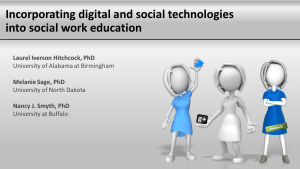#SWDE2016 Incorporating Digital & Social Technologies into Social Work Education
 Today is the Day 1 of the Second Annual Social Work Distance Education Conference, and I am lucky enough to be presenting with Drs. Melanie Sage (University of North Dakota) and Nancy J. Smyth (University of Buffalo, SUNY) about how to incorporate digital and social technologies into social work education. Our workshop will inform participants about the mechanics as well as the advantages and disadvantages of incorporating digital and social technologies assignments into social work courses. Topics to be covered include the importance of digital literacy and how to use theory to inform the integration of technology into their online courses. Participants will learn about example assignments and learning activities for social work courses that incorporating digital and social media such as microblogging, designing infographics, and creating a video. By the end of the workshop, participants will:
Today is the Day 1 of the Second Annual Social Work Distance Education Conference, and I am lucky enough to be presenting with Drs. Melanie Sage (University of North Dakota) and Nancy J. Smyth (University of Buffalo, SUNY) about how to incorporate digital and social technologies into social work education. Our workshop will inform participants about the mechanics as well as the advantages and disadvantages of incorporating digital and social technologies assignments into social work courses. Topics to be covered include the importance of digital literacy and how to use theory to inform the integration of technology into their online courses. Participants will learn about example assignments and learning activities for social work courses that incorporating digital and social media such as microblogging, designing infographics, and creating a video. By the end of the workshop, participants will:
1. Understand the importance of digital literacy in 21st century social work practice.
2. Demonstrate how digital and social technologies can be incorporated into assignments for social work courses.
3. Appreciate the role of theory to support the development and implementation of technology-based assignments.
Here is a link to the slides from the workshop: https://www.slideshare.net/secret/8jgUUNwPcTPt46.
We also shared the following handout: Technology-Based Learning Task List for Social Work Education.
Here is our abstract for the workshop:
Today’s social work educator may use a variety of digital and social technology tools, from learning management systems to social media applications, to engage social work students in learning (Burquoi et al, 2013). However, technology in social work education has been integrated sporadically with varying degrees of success. Additionally, there is a growing awareness that social work practitioners, students and educators need to be adept at using digital and social media and information communication technology as part of their practice and interaction with clients and organizations of all sizes. Social work educators can play a pivotal role in helping students to increase their own media literacy, and ultimately apply this knowledge to their own learning and subsequent practice.
This workshop will provide an introduction to social work educators wanting to enhance their online courses with digital and social technologies, expanding assignments and learning activities beyond the learning management system. First, social work educators who attend this session will learn about the importance of digital literacy and using theory to inform the integration of technology into their online courses. Different models of digital literacy will be reviewed including Belshaw’s Eight Elements of Digital Literacy (2014) and Rheingold’s five fundamental digital literacies (2012). Additionally, examples of theoretical constructs relevant to teaching with technology, such as motivational principles and multimedia learning principles, will be reviewed as well as benefits of learning with technology such as opportunities for repeated practice, reinforcement, and the use of technology-facilitated learning communities.
Second, the presenters will share example assignments and learning activities for social work courses that incorporating digital and social media such as microblogging, podcasting and creating a video. Assignments using Twitter, YouTube, and video and podcasting technologies can engage students in online courses as well as help students learn about technology tools and resources. Ruben Puentedura’s SAMR Model for Technology Integration (2014) will be reviewed as a model for adapting or transforming traditional assignments and learning activities for online learning environments. The presenters will also show how, through the use of digital and social technology-based assignments, students can actively engage in competency-based behaviors such professionalism, policy practice and critical thinking while also increasing digital media literacies (CSWE, 2015).
References:
Belshaw, D. (2014). The Essential Elements of Digital Literacies. Retrieved from http://digitalliteraci.es/
Buquoi, B., McClure, C., Kotrlik, J. W., Machtmes, K., & Bunch, J. C. (2013). A National Research Survey of Technology Use in the BSW Teaching and Learning Process.Journal of Teaching in Social Work, 33(4-5), 481–495.
Council on Social Work Education. (2015). Educational Policy and Accreditation Standards. Washington, DC: Author.
Puentedura, R. (2014). SAMR and Bloom’s Taxonomy: Assembling the Puzzle. Retrieved from: https://www.graphite.org/blog/samr-and-blooms-taxonomy-assembling-the-puzzle
Rheingold, H. (2012). Net Smart: How to Thrive Online. Camridge MA: The MIT Press.
How to cite this post:
Hitchcock, L., Sage, M., Smyth, N. (2016, April 13).#SWDE2016 Incorporating Digital & Social Technologies into Social Work Education[Blog Post]. Retrieved from https://laureliversonhitchcock.org/2016/04/13/swde2016-incorporating-digital-social-technologies-into-social-work-education/.


